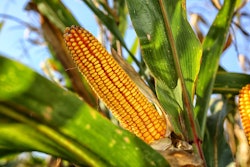
“The fundamentals always win in the end,” said Darin Newsom, senior market analyst for barchart, in his keynote address at barchart’s Grain Merchandising & Technology Conference.
“We can have algorithmic trading — that’s still important — but when the dust settles at the end of the day, week, month, or whatever timeframe we're studying, the fundamentals of supply and demand win in the end.”
Newsom said the “fundamentals rule” is critical to his unique perspective on analyzing commodities markets for grain merchandisers. There are two sources analysts can use to draw conclusions from, he said. One is to rely on USDA crop estimates and demand forecasts, and the other is to examine market signals.
“Over the decades when I’ve given these presentations, I'm looking at the latter,” Newsom said. “I'm going to look at what the markets are saying, and to do that, I start with the price chart.”
Corn, soybean and wheat market signals
Reflecting first on the state of corn, Newsom noted the 2023-24 marketing year is starting closer to the average, following a three-year cycle of corn shortages. He highlighted that current prices are lower, basis is weaker, and the cash index is mirroring the 2010-2014 pattern.
The current situation is following what corn prices experienced a decade ago, when the market hit a low point before rebounding slightly in the June to July timeframe. Newsom said that if the current trajectory continues to follow that pattern, there might be further downside to the overall cash corn market. He emphasized the return of demand for its potential to impact the market.
Turning his attention to soybeans, Newsom said tight supply is a key indicator that the market is sending a message of concern. He noted that already facing a shortage of soybean acres, there was a noticeable price surge in August, further reinforcing the market's apprehension.
On the other hand, wheat is experiencing an overabundance of supply. Despite factors like Russia's invasion of Ukraine and droughts in Australia, there's one crucial element to consider: The significant increase in the maximum storage rate from five cents to eight cents per bushel per month, effective in 2019, indicates there is not a bullish market sentiment. Newsom said the situation means the market is willing to pay storage and interest to prevent the commodity from being sold.
USDA-based perspective
Mark Soderberg, senior agricultural market analyst for ADM Investor Services rounded out the keynote address with his analysis. Mark Soderberg, senior agricultural market analyst, ADM Investor Services.Elise Schafer
Mark Soderberg, senior agricultural market analyst, ADM Investor Services.Elise Schafer
“One thing I couldn’t agree more with Darin is his statement on how supply and demand drives this market,” Soderberg said. “They always have and always will, in my opinion. With that said, I do look at things slightly differently and work with the USDA’s perspectives to inform my research.”
Soderberg’s analysis examined USDA corn production reports from August to the final reports since 1999, focusing specifically on years when the USDA reduced production and yield figures in August, similar to what occurred in 2023.
Out of the 15 instances since 1999 when Soderberg’s production estimates differed from the USDA's August projections, his estimates turned out to be more accurate six times. Two standout years of 2011 and 2003, production dropped between 650 million bushels and 400 million bushels. While Soderberg doesn't anticipate such a drastic decline this year, current crop conditions have deteriorated since mid-August.
Soderberg predicted a 2.1 billion bushel reduction in corn production estimates from the USDA's August projection for its Sept 12 report. Historically, when the USDA lowered production and yield in August, actual production figures tightened towards the end of the season, which has happened 13 out of 17 times since 1990. While we may not experience a production drop as drastic, a 5% reduction in production would still be significant, Soderberg said.
Additionally, Soderberg touched on biodiesel and renewable diesel production in the US. He noted capacity in this sector has been expanding in recent months, with record production levels and high usage. This expansion is expected to impact soybean oil usage, and while alternatives exist, they may not be sufficient to meet growing demand, which could result in lower exports and higher crush numbers.
Soderberg added that, ahead of the upcoming USDA report, it's important to remain cautious, as even experienced traders can be caught off guard by unexpected market developments.
barchart's Grain Merchandising & Technology Conference was held Sept. 10-12 in Nashville.


















